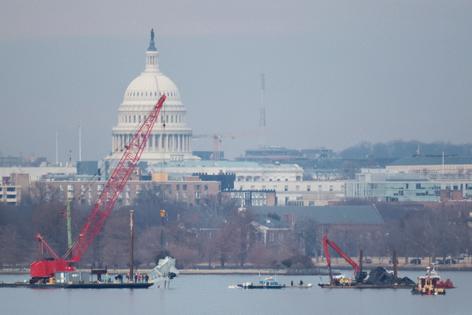Hill looks to boost safety of military flights near airports
Published in News & Features
WASHINGTON — More than a half year after an Army helicopter and a jetliner collided over the Potomac River in the deadliest aviation accident in nearly a quarter century, the Armed Services committees are seeking to improve the safety of U.S. military flights near commercial airports.
The House Armed Services Committee’s fiscal 2026 defense authorization bill would forbid military helicopter training flights within a 30-mile radius of Ronald Reagan Washington National Airport, or DCA, unless the helicopters are “actively providing warning” during their flights of their position to nearby commercial aircraft “in a manner compatible with the traffic alert and collision avoidance system of such commercial aircraft.”
Still, the House bill would permit a military service secretary, in consultation with the secretary of transportation, to waive that requirement if certain criteria are met — including if U.S. national security requires it.
The requirement for military helicopters to use position-warning equipment near DCA — alongside several related provisions in both the House and Senate NDAAs — are the latest congressional responses to the Jan. 29 midair collision near DCA between an Army Black Hawk helicopter and a regional passenger jet, which killed all 67 people on the two aircraft.
Since then, more near misses between military aircraft and passenger jets have further focused congressional attention on the subject.
Rep. Jack Bergman, R-Mich., chairman of the House Armed Services Readiness Subcommittee, said at the full committee’s markup of its NDAA on July 15 that he was “particularly troubled” by the DCA crash, and he said the House NDAA would help “reestablish safety as a culture.”
‘Direct responsibility’
At a March hearing of a Senate Commerce, Science and Transportation Committee, federal officials confirmed that at the time of the January crash at DCA, the Black Hawk was not using its Automatic Dependent Surveillance-Broadcast system, which broadcasts an aircraft’s position, altitude and speed. The system is referred to as ADS-B Out or ADS-B In.
The Army has said the system is sometimes turned off during training missions that rehearse ferrying top government officials in classified continuity-of-government operations. Other factors also have been found to have contributed to the January crash, according to a preliminary investigation.
At the March hearing, Chris Rocheleau, then the acting chief of the Federal Aviation Administration, said the agency had put in place a memorandum of understanding with the Defense Department and other agencies that use DCA airspace that requires all aircraft to have the ADS system turned on.
But senators seemed eager for a more permanent fix than a memorandum, and the NDAA may be one venue for enacting it.
Sen. Ted Cruz, R-Texas, the Commerce panel’s chairman, said at the hearing that if the Army does not require use of the position-warning system, “I have a high level of confidence that Congress will pass legislation mandating that you revisit the policy. If today another accident occurs over DCA with another helicopter that had ADS-B Out turned off, the Army will have very direct responsibility.”
‘Close calls’
The crash was a lethal anomaly, but close calls between military and civilian aircraft are not unusual, at least at DCA, experts have said.
Jennifer Homendy, chair of the National Transportation Safety Board, told reporters earlier this year that a commercial plane and a helicopter had a “close call” at DCA at least once a month between 2011 and 2024.
In May, just a few months after the deadly January crash, two jetliners at the same airport had to abort landings to avoid colliding with another Black Hawk helicopter.
Beyond DCA, near misses in midair between military aircraft and commercial passenger jets are not unheard of.
In March, an Air Force T-38 Talon training jet and a passenger jet nearly collided over Northern Virginia.
And just last week, a B-52 bomber and a passenger jet narrowly avoided hitting each other over North Dakota.
NDAA provisions
The new House NDAA, which the chamber hopes to vote on in September, has other provisions pertaining to the issue beyond the requirement for military helicopters to keep collision avoidance systems on when flying near civilian airports.
The House bill also would require the Army secretary to update lawmakers by year’s end on all investigations of the January crash at DCA. And the measure would require the secretary to provide a plan for communicating with the families of the deceased passengers.
Meanwhile, the Senate Armed Services Committee’s companion NDAA bill, which also could be debated by the Senate after the August recess, would require that all military aircraft operating near commercial airports be “equipped with” position broadcast technology.
But, unlike the House bill, the Senate measure does not appear to require that the system be turned on while the military aircraft are flying in proximity to jetliners.
The Senate’s NDAA would also mandate that the Pentagon develop a program for sharing with the Federal Aviation Administration certain aviation safety data about Defense Department aircraft “to include near misses and mishaps.”
The Senate bill would also require a report within six months after the bill’s enactment on near misses between military and commercial planes in the preceding decade, including the details of the incidents and any changes to protocol made in response.
The report would have to be produced annually thereafter.
_____
(Briana Reilly contributed to this report.)
©2025 CQ-Roll Call, Inc., All Rights Reserved. Visit cqrollcall.com. Distributed by Tribune Content Agency, LLC.







Comments